Dude! Take Your Turn!
A Gaming Life
Boardgame Geek Top 200 – Play or Played – #190-181
Posted on September 2, 2020 by whovian223
When I began this series about the Boardgame Geek rankings and talking about the games in them, I didn’t think it would be this difficult.
The Top 100 was pretty static. So when I spent the first part of the week putting all of the games and the rankings in, getting the social media links going as well as linking to all of the web sites, I didn’t really have to worry that by the time I wrote the actual content of the post, all of the rankings would have changed.
For #100-200, that seems to actually not be the case.
Granted, this post coming out 3 weeks after the last one doesn’t help, but in between doing the “busy work” for this post and actually writing it, a whole bunch has changed!
So much so that I had to do a quick adaptation and came to the realization that I’m going to have to do these posts quicker than I thought I would to avoid the issue.
Seriously, the rankings are bouncing around like crazy.

But I shall persevere!
And try to be more timely as well.
Good luck with that.
And on that note, let’s begin!
#191 – Hero Realms (White Wizard Games) – 2016

Designers: Robert Dougherty, Darwin Kastle
Artists: Randy Delven, Vito Gesualdi, Antonis Papantoniou
What, #191? That’s not in this post, is it?
Yes, between me forming this post and actually finishing it, Hero Realms fell to #191, so I’m including it here (it was #190 when I started this post).
That just means you get an extra game in this post!
Hero Realms is a sister game to White Wizard’s Star Realms deckbuilding card game where each player is trying to attack the other player and make them lose all of their Authority (i.e. Health).
In Hero Realms, it actually is Health that they are losing.
As with all deckbuilders I’ve seen, each player starts with a 10-card (some deckbuilders do 12 cards) deck with cards that give you one coin or one combat when you play them.
There’s a market for players to purchase more powerful hero cards and spells that will build up your deck and let you do some major damage to their opponent and their heroes.

Market cards are one of four factions and playing cards in the same faction can make them even more powerful.
Champions stay out on the table when you’ve played them until they are destroyed by your opponent. Each one has health (bottom left corner) which is how many attack points is required to kill them. As long as they are in play, you will get their effects one every one of your turns.
If the health is in a black shield, then this champion must be killed before you can attack your opponent. If it’s in a grey shield, then you can attack the champion or you can attack the player.
I enjoyed the game, just like I do Star Realms. However, there’s not a lot different between the two.
The terminology may be slightly different (“Destroy Target Base” in Star Realms becomes “Stun Target Champion” in Hero Realms) but overall the play is very similar.
That being said, I did enjoy my one play of it a couple of years ago. I’d definitely play it again if it was offered (or if they made an app like Star Realms, hint hint White Wizard).
#190 – Power Grid Deluxe (Rio Grande Games) – 2014
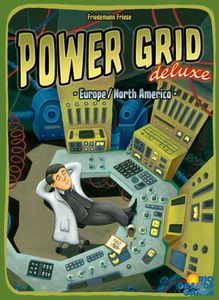
Designer: Friedemann Friese
Artist: Harald Lieske
Do you like Math?

If you do, then you’ll love Power Grid. This is the “new” deluxe edition that came out in 2014 and I guess has a separate entry from the original game (which may be higher on this list, I’m not sure…what, you want me to look ahead? Too much work).
What you are doing is essentially trying to power a huge portion of (in this edition anyway) Europe or North America by building power plants and then placing buildings in various cities.

The original Power Grid was #36 in the Top 100 (ok, yes, I did go and check), so check that out for the full description of the game.
But know that you will be calculating a lot of numbers.
#189 – Glory to Rome (Cambridge Game Factory) – 2005

Designers: Ed Carter, Carl Chudyk
Artists: Ed CarterValerio CioniKlemens FranzFelix GirkeHeiko GüntherIgor Wolski
Glory to Rome is one of those grail games, especially because it’s been out of print for so long.
It’s also extremely nasty from what I’ve heard and seen (there’s a reason that the “curse” phrase on Heavy Cardboard videos is “Glory to Rome!”).
Sadly, I have never played it. A friend tried to teach it to me a few years ago, but there were a couple of problems. First, I don’t think it’s a great 2-player game. Secondly, my friend was not a good teacher and I had no idea what was going on.
But it’s something I’d love to play once! Just to say I did.
Since I can’t really describe it, let’s blurb this:
“Glory to Rome is a card-based city building and resource management game with a novel mechanism. Each card may act as a building, a client, a raw material, or a valuable resource, frequently forcing players into difficult decisions regarding how each card should be used. In addition, much of the game is played from the discard pool, giving players some control over what cards are accessible to opponents. Actions are triggered by a form of card-driven role selection — the active player leads a role, and other players may follow if they discard a matching card from hand (to the pool). Players who don’t follow may ‘think’ to draw more cards. There are thus strong interactions between the different uses of cards. Scoring is a combination of completing buildings and storing resources, with end-of-game bonuses for storing a diverse assortment. Game length is player-controlled, and is triggered in a few different ways.”
The game is really fun to watch if the right people are playing it. Watching the Heavy Cardboard playthrough was hilarious, but it’s sadly only for patrons.
If you can find a good video, though, check it out.
It looks like tons of fun.
#188 – Lewis & Clark: the Expedition (Ludonaute) – 2013
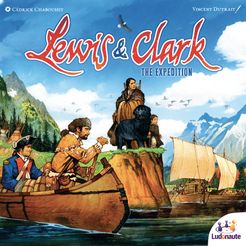
Designer: Cédrick Chaboussit
Artist: Vincent Dutrait
Lewis & Clark: the Expedition is essentially a race game.
You are trying to reach the ocean on the other side of the Rocky Mountains before the other players.
However, there is a lot of nuance behind all of that.
Each player starts with a hand of cards, and you will be buying more during the game to try to enhance your abilities to move along the Missouri River and get to that goal.

You can only carry so many resources on your boats, so you do have to collect things wisely.
On your turn, you’ll be playing one card and then either using one of your Native American guides to power the card or using the back of another card (thus making it unavailable to you at the moment).

If you have enough equipment and furs, you can buy another card at the end of your turn. This card will go into your hand and be available for use starting next turn.
If you have any Native Americans on your boats, you can send them to the village on the board to either get resources, get boats or horses, or perhaps you can even add to your boat caravan.

Your camp is marked on the board with a little arrow marker. Your explorer will move down the river as you go. At the end of your turn, you can choose to camp if you want (or even at the beginning of your turn, I think).
This may not be as straightforward as you think, though. For each card still in your hand, your explorer moves back one space. Depending on your caravan and how many resources and natives you have on your boats, you may have to move your explorer back further towards your original camp.
Wherever your explorer ends up, that’s where your new camp is.
You take all of your cards from in front of you and put them back in your hand, and you’re ready to start the next day.
Ultimately, the game is a push and pull of playing cards and trying to make sure your camp actually advances. There’s nothing more demoralizing than having your explorer way far ahead of everybody else but then you end up having to backtrack a bunch of spaces to your camp.

This is a fun game, but I’m not very good at it.
I’ve played it 5 times but nothing in the last year or so. I’ve played it on Boardgame Arena a few times. One time I won with no problems. The next game I was stuck near the back of the pack.
It’s all in the cards you get and how you play them.
I’d definitely continue playing this one, though it’s not something I would necessarily suggest.
It is fun, though.
#187 – Tyrants of the Underdark (Gale Force Nine) – 2016
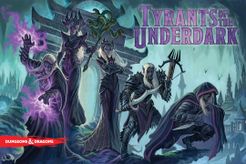
Designers: Peter Lee, Rodney Thompson, Andrew Veen
Artist: Steve Ellis (and many more!)
Tyrants of the Underdark is one of my favourite games. I’ve done a review of it and it’s also in my Top 5 games played of all time!
It’s a wonderful deckbuilding game that also has area control and all of the player conflict that you could want (though you can also terrorize the “neutral” faction as well).
The only thing that mars the game is the extremely dark colour palette and how two of the player colours are so close together that you don’t even have to be colorblind to have trouble telling them apart without bright light (which the picture below has).

Otherwise, though, this game is amazing!

The map of the Underdark has plenty of places to place your soldiers and many victory point locations that you just need to have the most soldiers there for.

I really love the deckbuilding aspect, though, with the same market of cards that every other deckbuilder has, but in this game you only choose two factions of cards to include in each game (out of 4, or 6 if you have the expansion).
Again, the colour palette is too dark. The card artwork is amazing but you can hardly see it.
But that doesn’t mean the game is bad. It is a great game and I wish Gale Force 9 would support it with another expansion (hopefully this time keeping the cards feeling the same as the original cards, as the expansion had cards that you could easily tell were from the expansion).
This is a game I will never turn down. I sadly have not got it to the table recently but that will change after the pandemic is over. So I guess next year.
Sigh.
#186 – Isle of Skye: From Chieftain to King (Lookout Games) – 2015
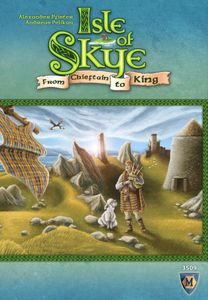
Designers: Andreas Pelikan, Alexander Pfister
Artist: Klemens Franz
This is another game that I’ve played the app version for but never played on the table.
Isle of Skye is essentially a tile-laying game where each player is a chieftain trying to form the greatest territory on the aforementioned island in order to become King!
The game is played over four rounds and as you build your kingdom, you need to pay attention to the four scoring tiles that are out there.
At the end of each round, you’re going to be scoring one or two of those in a certain order.

Thus, as you are laying tiles, you have to keep future scoring in mind as well as current, especially if you have a tile or two that doesn’t help with current scoring anyway.
The really interesting thing about Isle of Skye, though, is how you purchase the tiles.
Each player will put two of the tiles in their hand up for sale, setting the price for each one. You want to set the prices so that you’ll get a good amount of money, but the problem is that if nobody buys them, you have to buy them and put them in your kingdom.
If you price them too high, that could get really expensive for you!
I do really like tile-laying games like this, though I’m not very good at them. I sometimes end up joining two clusters together into one big one, or something else stupid like that, costing me points.
But the game looks pretty cool and the app is great (a few multiplayer bugs which may have been fixed by now since it’s been a while since I’ve played it).
I’d love to try this on the table once, just to add it to my “played games” pile.
Because I’m a mercenary like that.
#185 – 1830: Railways & Robber Barons (Lookout Games) – 1986

Designer: Francis Tresham
Artists: Mike Atkinson, Jared Blando, Charles Kibler, James Talbot, Mark Zug
And we hit our first 18XX game. 1830 is a classic of the genre, from what I understand.
Players are trying to make the most money by owning and operating railways as well as buying and selling stocks.
My addled brain has never understood the attraction of 18xx games, but a ton of people love them so I guess I’m wrong! I thought Power Grid was bad for math, but these games just seem to ramp that up to 11. Also the stock manipulation part of the game is just something that’s never really appealed to me.
So since I (very obviously, right?) have never played this one, let’s blurb it!
“This game takes the basic mechanics from Tresham’s 1829, and adds several new elements. Players are seeking to make the most money by buying and selling stock in various share companies located on eastern United States map. The stock manipulation aspect of the game is widely-regarded as one of the best. The board itself is actually a fairly abstract hexagonal system, with track tiles placed on top of the hexes. Plus each 18xx title adds new and different elements to the game. This game features private rail companies and an extremely vicious, ‘robber baron’ oriented stock market. A game is finished when the bank runs out of money or one player is forced to declare bankruptcy, and the player with the greatest personal holdings wins.”
Sorry, this just has no appeal to me whatsoever. However, one of my friends loves these games so I do understand that it might just be me.
Let’s see if my friend Dave actually reads this and comes out of the woodwork to extol the glories of 18XX.
#184 – Sushi Go Party (Gamewright) – 2016

Designer: Phil Walker-Harding
Artist: Nan Rangsima
Sushi Go Party is the ultimate in fast and easy card drafting and set collection games.
Unfortunately, I forgot to take pictures (Editor: There will be a flogging).
Essentially, each player is dealt a hand of sushi cards of various types. You will take one of those cards and pass the rest to the player next to you (it alternates round by round whether it goes left or right).
When everybody has selected their card, you reveal it and place it in front of you. The cards will score various points at the end of the round or game based on what sets of cards you are collecting.
Some sets will give you points if you collect a certain number of them but no points if you don’t (meaning your opponents are going to try and hate-draft that third or fourth or whatever card in the set to make sure you don’t get it).
Others will give you points for certain other combinations, or when combined with other sets.
The original Sushi Go was a great game but the Party version has so many sets that you can choose which ones to use in your game, meaning there will be a lot of variety in future plays.
It also makes it so you can have up to 8 players!
My memory of the game (both versions) is that it’s a lot of fun and a great way to kill 10-20 minutes while you’re waiting for other players or if you want to finish off the night with something fun.
#183 – Cartographers: a Roll Player Tale (Thunderworks Games) – 2019
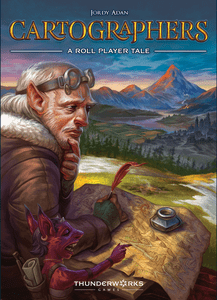
Designer: Jordy Adan
Artists: Luis Francisco, Lucas Ribeiro
Cartographers is a “roll and write” (really a “flip & write” but they’re part of the same genre) game where you are exploring the world of the Roll Player universe.
When I first started this post, this was going to be a game I’d never played before.
However, since I started it, the app has been released and I’ve played a few games of it.
It’s really cool!
Still not something I’d play on the table unless I had to (sorry, but I hate drawing things as part of my games, especially different shapes on a grid pattern).

Essentially you are using cards to chart the world by drawing shapes on your player sheet on an 11×11 squares grid. Cards will come up either as one type of terrain and two shapes (one possibly worth a gold piece) or two types and one shape.
You get to decide how you want to draw them on your map. You can pretty much put them anywhere unless the a “Ruins” card is drawn. In that case, you have to include one of the free Ruins spaces in the next shape you draw.
Each card costs a certain amount of “time.” When the time limit for each season (there are 4) is passed, then you score based on two of the four scoring cards that are out.
Much like Isle of Skye mentioned above, there are four scoring cards and each round you will score two specific ones. On the first round, you’ll score A & B. On the second, B & C will score. Third one is C & D. The final round will be A & D.

I find that scoring method incredibly cool.
There is always a chance that a monster card comes out (or even two if none came out the previous season!). When that happens, you pass your map to the player next to you, they put monsters on your map in the correct sequence, and pass it back to you.
You get points for matching what the scoring cards say. You lose a point for each open space next to a monster.
At the end of the year, you total up your score. Whoever has the most is the winner!
For the solo mode, each scoring card has a number that has to be subtracted from your total. So you’re trying to end up with 30 points to be a master cartographer.
The game does look pretty fun and I have to say the app is great (more on that in a future post).
However, being something that I have to draw with, it’s not really something that I would play that often on the table.
Nothing against the game itself.
Just my own feeling.
If you like roll & writes, then you’ll probably love this one!
#182 – The Quest for El Dorado (Ravensburger) – 2017
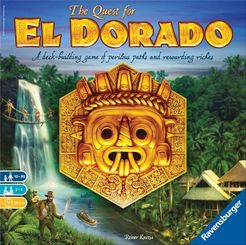
Designer: Reiner Knizia
Artists: Vincent Dutrait, Franz Vohwinkel
The Quest for El Dorado is another race game (they seem quite popular in the bottom half of the Top 200!). It’s also a card-drafting game with a modular board and hand management aspects.
It’s also a game I have never even seen, much less played.
Which makes me sad, because it sounds like it would be right up my alley.
Let’s blurb this thing!
“In The Quest for El Dorado, players take the roles of expedition leaders who have embarked on a search for the legendary land of gold in the dense jungles of South America. Each player assembles and equips their own team, hiring various helpers from the scout to the scientist to the aborigine. All of them have one goal in mind: Reaching the golden border first and winning all of the riches for themselves. Whoever chooses the best tactics will be rewarded!”
That…wasn’t very helpful, actually.
I’m assuming the “assembles and equips their own team, hiring various helpers…” is about the drafting?
It must be.
Anybody else play this and want to chime in on how it plays?
Because I have no idea.
It’s Knizia and I’ve heard great things about it, though, so I really do want to try it once!
I don’t think I’ve said this yet in this second series of posts (maybe I have), but all together now…
“maybe at a convention!”
Some day.
#181 – YINSH (HUCH! & Rio Grande Games) – 2003
/pic2844830.png)
Designer: Kris Burm
Artists: Kris Burm, lu’cifer
Finally, we get to one of the few abstract games I’ve seen on these lists. The fact that this came out in 2003 says something about its staying power too.
However, while I think I’ve seen this on the table (brought by one of my friends), I’m not really sure.
YINSH seems to have some similarities to Othello in the fact that there are markers on the board that can be flipped from one colour to the other after you move a piece (though in Othello you are placing pieces, not moving them).
Let’s end this post with another blurb!
:strip_icc()/pic43617.jpg)
“In YINSH, the players each start with five rings on the board. Every time a ring is moved, it leaves a marker behind. Markers are white on one side and black on the other. When markers are jumped over by a ring they must be flipped, so their color is constantly changing. The players must try to form a row of five markers with their own color face up. If a player succeeds in doing so, he removes one of his rings as an indication that he has formed such a row. The first player to remove three of his rings wins the game. In other words, each row you make brings you closer to victory-but also makes you weaker, because you have one fewer ring to play with. Very tricky!”
I love the sound of this game, though I have a feeling it would burn my brain.
I like the sound of how moving towards success actually makes the game harder because you have fewer pieces to work with.
It also looks like a beautiful game (though this could be an old version, I’m not sure)
So there you have it. After way too many weeks, the second part of looking at the Top 200 games on Boardgame Geek!
And there are 11 games to look at due to BGG ranking volatility. Bonus for you!
That’s 5 games played out of 11, with 2 more that I’ve played the app versions of. So far, that’s 9 played out of 21.
Could be better!
What do you think of these games? Played any and hated them? Love them to death? Love 18XX and want to put me in the stocks because I don’t?
Let me know in the comments.
Posts in this Series
#200-191
#190-181
#180-171
#170-161
#160-151
#150-141
#140-131
#130-121
#120-111
#110-101
Category: Board Games, Top 10Tags: 1830: Railways & Robber Barons, 18XX, Abstract Games, Alexander Pfister, Andreas Pelikan, Andrew Veen, Area Control, Cambridge Game Factory, Card Drafting, Card Games, Carl Chudyk, Cartographers: a Roll Player Tale, Cédrick Chaboussit, Darwin Kastle, Deckbuilders, Economic Games, Ed Carter, Francis Tresham, Friedemann Friese, Gale Force 9, Gamewright Games, Glory to Rome, Hand Management, Hero Realms, HUCH Games, Isle of Skye, Jordy Adan, Kris Burm, Lewis & Clark: the Expedition, Line-Drawing Games, Lookout Games, Ludonaute, Peter Lee, Phil Walker-Harding, Power Grid Deluxe, Racing Game, Ravensburger, Reiner Knizia, Rio Grande Games, Robert Dougherty, Rodney Thompson, Sushi Go Party, The Quest for El Dorado, Thunderworks Games, Tile-Laying Games, Tyrants of the Underdark, YINSH
20 Comments on “Boardgame Geek Top 200 – Play or Played – #190-181”
Leave a comment Cancel reply
This site uses Akismet to reduce spam. Learn how your comment data is processed.
About this Blog
This is a blog about board games, with the occasional other post for a bit of spice.
Pingback: Boardgame Geek Top 200 – Play or Played – #200-191 – Dude! Take Your Turn!
2 out of 10 for me (Isle of Sky and Power Grid). I was not aware that the lower 200’s are so volatile as far as the rating is concerned.
LikeLiked by 1 person
What do you think of Isle of Skye? Since I’ve only played the app, I’m wondering how it is on the table.
And oh yeah, I think almost every one of these games shifted positions (and YINSH must have fallen from 180 or something because it wasn’t in this list when I first put it together).
LikeLiked by 1 person
As for Isle of Skye, I played once, during Essen fair. I vaguely remember that is was pretty nice euro but didn’t impress me as much as Clans of Caledonia which I also played during that con.
LikeLiked by 1 person
Two very different games. LOL But glad to see it was pretty good overall.
LikeLike
3 out of 10 for me, though none of them are games I own or would be excited to play again: Quest for El Dorado, Lewis and Clark, and Sushi Go Party.
Sushi Go Party I played at…you guessed it, a party. And I generally am nonplussed by party games, this was no exception. I have no issue playing games at parties, and it beats standing around awkwardly at parties, which is what I usually do (so be sure to invite biffpow to your next bash!), I just think of them less as games and more as party activities.
L&C and Q4ED are similar, as I recall, though I remember liking Q4ED more. I remember feeling like I had more flexibility in terms of strategy. And the L&C felt a little too luck dependent. Or I may have just missed its nuances. Both seem like games I should like a lot, so maybe I should give them another shot.
I’ve played regular Power Grid and would not play Power Grid-anything ever again–math and I do not get along.
I’d never heard of Yinsch, which is kind of unusual, but I also don’t pay a lot of attention to abstracts as my group frowns at them.
LikeLiked by 1 person
I don’t really see Sushi Go and the Party as party games. More like quick drafting games like 7 Wonders (though even quicker than that).
But I can see why you might feel that way.
L&C can be luck-dependent based on what cards come out to buy, but other than that I don’t think there’s a lot of luck in there. You’re pretty much in control of everything you do, but if there are no characters out there to buy that you want, I can see the frustration.
I’m not as against Power Grid as you are, but it’s not something I’m dying to play again. I actually almost won once! Lost on the tie-breaker.
Thanks for stopping by! I was wondering where you were and then I realized today that I had never actually posted these to Stately Play. Whoops!
LikeLiked by 1 person
I was not very active online the last 2 weeks–we were ordered to evacuate 2 weeks ago due to the wildfires in CA. It looked very bleak for a while, but somehow the town was saved. A neighboring town, 5 minutes away, was completely destroyed. Reinforcements arrived in time to protect the town, though, and remarkably there was no damage in our neighborhood at all.
Can 2020 be over already? I feel like I’ve aged five years in the last five months.
LikeLiked by 1 person
I wish 2020 could be over! I want my game days back.
Glad that you’re doing ok. Sounds scary! I don’t know how well I would handle that.
LikeLike
I’m not a big fan of tile-laying games either, and I haven’t played all that many auction games, but Isle of Skye definitely hits a sweet spot for me. Plus, adorable Highland animals!
LikeLiked by 1 person
yeah, those animals are pretty cute. 🙂
LikeLiked by 1 person
…also, I’m a sucker for anything Scottish.
LikeLiked by 1 person
As am I…especially if she has red hair. 😛
LikeLike
Pingback: Boardgame Geek Top 200 – Play or Played – 180-171 – Dude! Take Your Turn!
Pingback: Boardgame Geek Top 200 – Play or Played – #170-161 – Dude! Take Your Turn!
Pingback: Boardgame Geek Top 200 – Play or Played – #160-151 – Dude! Take Your Turn!
Pingback: Boardgame Geek Top 200 – Play or Played – #150-141 – Dude! Take Your Turn!
Pingback: Boardgame Geek Top 200 – Play or Played – #140 – 131 – Dude! Take Your Turn!
Pingback: Boardgame Geek Top 200 – Play or Played – #130-121 – Dude! Take Your Turn!
Pingback: Boardgame Geek Top 200 – Play or Played – #120-111 – Dude! Take Your Turn!